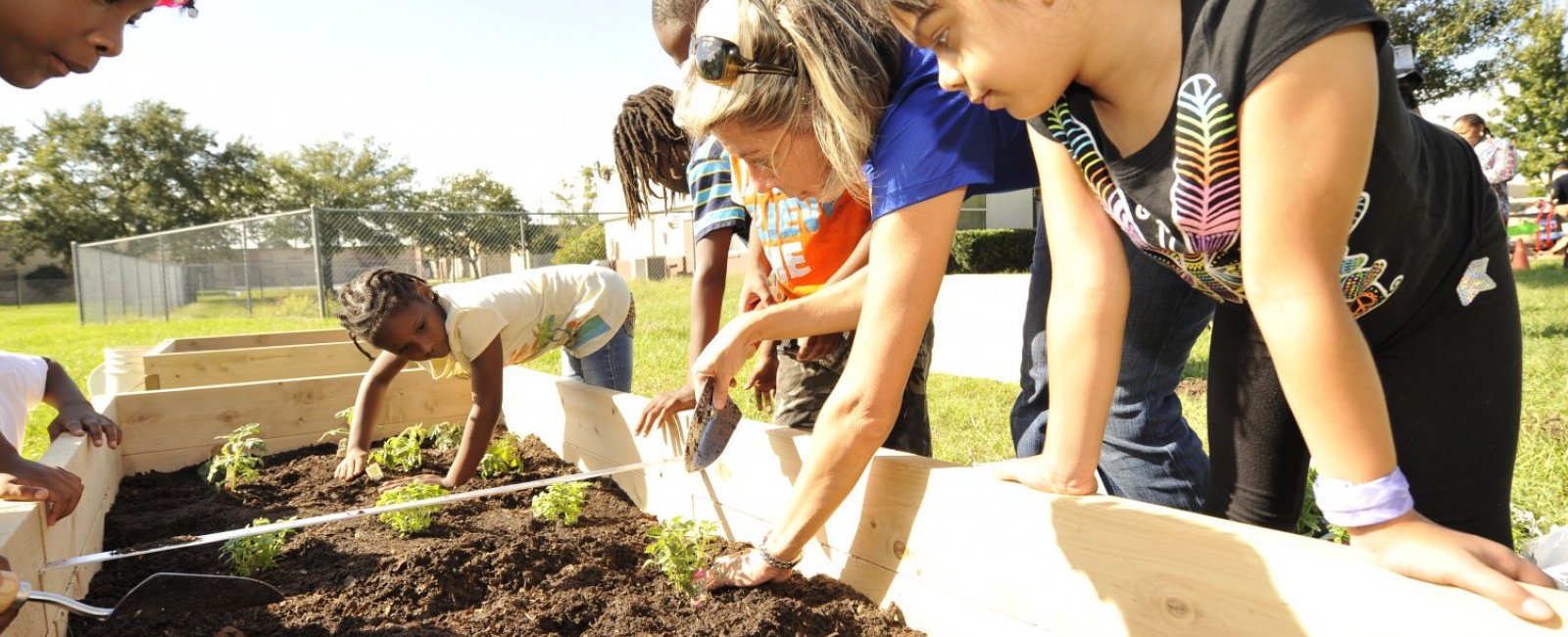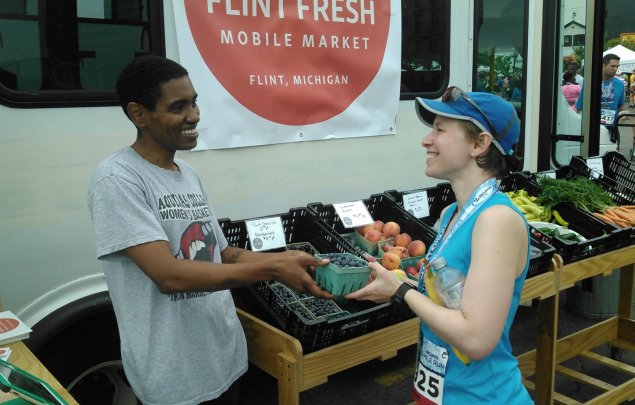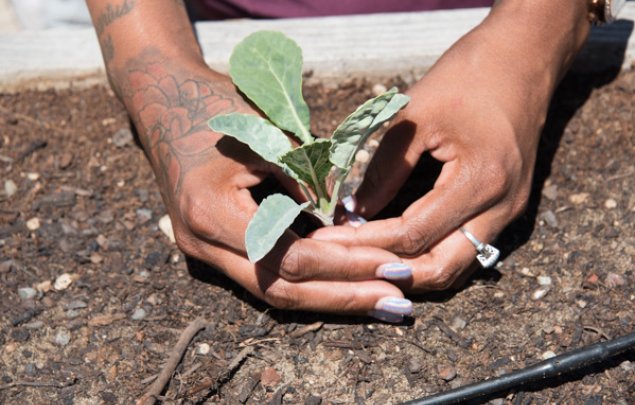From school gardens to farmers markets, community investments pay off
Takeaways
- A region-wide community health needs assessment (CHNA) identified poverty, access to healthy food, and obesity as persistent problems across central Florida.
- Significant areas have low, poor, or no access to healthy retail food outlets, based on Modified Retail Food Environment Index scores.
- Twenty-five percent of adults are obese and 10 percent have diagnosed diabetes.
- Orlando Health’s community benefit strategy around increasing access to healthy food is a means to prevent obesity and reduce health care costs for diet-related health conditions.
- Through partnership and community grants, Orlando Health funds multi-faceted programs:
- Healthy Teaching Garden: With support from Orlando Health’s Arnold Palmer Hospital for Children, 345 students at Orange Center Elementary learn about the importance of healthy eating and physical activity via a teaching garden. With the garden, healthy lifestyle lessons are incorporated into reading, writing, art, science, math, and other curricula. There is also a STEM (science, technology, engineering, math) component to the garden.
- Second Harvest Food Bank of Central Florida: The Orlando Health Community Grant Program supported multiple projects, including expanded refrigeration and healthy meals for at-risk populations.
- Goldsboro Farmers Market: Increases healthy food access and creates business opportunities for residents to sell homegrown food.
- Hospital Size: Medium (158 beds)
- Hospital Type: Private, nonprofit children’s hospital
- Geographic Area: Metro/urban
- System Network: Orlando Health
- Network/system/hospital coverage: Central Florida
- Race
- Asian: 5.6%
- Black: 22.2%
- White: 69%
- Identify with more than two racial groups: 2.5%
- Ethnicity
- Hispanic: 30%
- Non-Hispanic: 70%
- CHNA Region: Orange County
- Population: 1.3 million (Orange County)
- Adult Obesity: 25%
- Poverty: 18.2%
- Stephanie Carrington, Orange Center Elementary STEM coordinator
Orange County, Florida, home to Arnold Palmer Hospital for Children, has a growing and increasingly diverse population. The county experienced a 40 percent population increase between 2000 and 2014. Children under age 14 make up the largest portion of the county’s population (19 percent). Nearly 20 percent of children live below the federal poverty level and 61 percent qualify for free or reduced lunch.
Orange County residents face significant health and economic challenges related to food. Obesity is an issue across the age spectrum, and many areas have limited access to healthy foods. Across Orange County, there are multiple areas designated as food deserts that overlap with areas having high numbers of residents who receive Supplemental Nutrition Assistance Program (SNAP) benefits. The majority of census tracts across the region also reported low fruit and vegetable expenditures.
Community health needs assessment: Priorities and process
- Food and diet-related disease priorities: obesity, diabetes, heart disease, access to quality and nutritious food
- Participation by food-related organizations: Second Harvest Food Bank of Central Florida
- How/why did food issues emerge as priority area?
- Primary data (community conversations, stakeholder interviews, and consumer surveys) and secondary data revealed food insecurity, specifically access to nutritious foods, as an issue.
- Key community indicators (for Orange County):
- Upward trend of high school students with body mass index (BMI) greater than the 95th percentile.
- Increasing rate of diabetes hospitalizations for children 12 to 18 years old.
- Twenty-five percent of adults are obese and 10 percent have diagnosed diabetes.
- Presence of multiple food deserts, which overlap with areas where a high number of SNAP beneficiaries live.
- A significant portion of the county has a Modified Retail Food Environment Index score indicating low, poor, or no access to healthy retail food outlets.
- All census tracts across the region reported low expenditures for fruits and vegetables.
Full Assessment: Central Florida Community Benefit Collaboration 2016 Community Health Needs Assessment
Assessing health needs — and how to meet them
Community health needs assessment process
Orlando Health conducted its CHNA as part of the Central Florida Community Benefit Collaboration. Established in 2016, this effort brought together three health systems and the health departments of Lake, Osceola, Orange, and Seminole counties. The report combines a regional perspective with county-level views and supports comprehensive planning efforts across health departments and hospitals.
The collaboration’s participants identified organizations and stakeholders to take part in the CHNA process, looking for both a diverse set of perspectives and for far-reaching presence in the region. Second Harvest Food Bank of Central Florida, which works with more than 500 organizations across Central Florida, met those criteria. In addition to its food bank, it runs a culinary job training program, SNAP and Women, Infants, and Children (WIC) Food and Nutrition Service benefit enrollment services, and disaster relief programs. With its broad presence and first-hand knowledge of community food needs and resources, Second Harvest made valuable contributions to the assessment process.

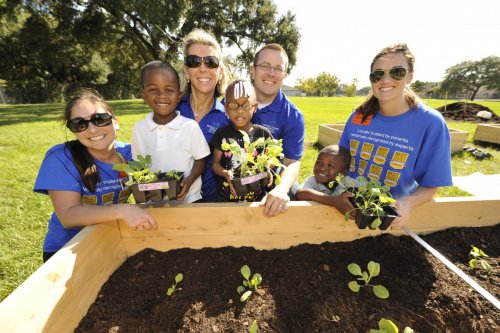

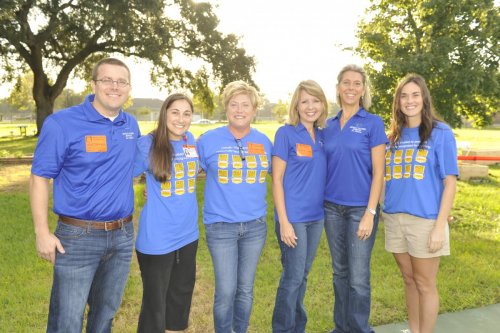
Healthy Teaching Garden
Orange Center Elementary School’s garden creates an interactive venue for students to see up close and learn how plants grow a while implementing good food choices. Hospital team members dedicate time to delivering health and nutrition education and to planning and carrying out planting and harvest days (Orlando Health).
The 2016 assessment identified poverty among its key “areas of concern.” Across secondary and primary data review (including a consumer survey, provider survey, stakeholder in-depth interviews, and community conversations) healthy food access and affordability stood out as significant health issues. For Orange County specifically, obesity, heart disease, diabetes, food insecurity, and access to care were identified as key health themes.
Orlando Health’s CHNA and community benefit efforts are conducted through the community benefit department, which falls under external affairs and community relations. Lainie Fox Ackerman, director of community benefit, oversees the CHNA process and the community benefit activities of the system’s nine wholly-owned or affiliated hospitals.
Individual hospitals undertake community benefit activities that align with the system’s identified priority health needs and address the needs of the specific populations they serve. Primary prevention of obesity, the focus of Arnold Palmer Hospital for Children, aligns with Orlando Health’s system-wide focus on access to care issues and connects back to the understanding that influencing children’s behaviors will help them grow into healthy adults.
Investing in solutions
Implementation strategy
Orlando Health’s community benefit strategy combines financial support and direct team member participation. The health system’s community grant program supports multiple initiatives designed to increase access to healthy food. Team members take part directly in project related activities (nutrition education) and through involvement in collective efforts to address health and hunger issues for highly vulnerable populations.
Healthy Teaching Garden - Orange Center Elementary School
Orange Center Elementary School’s garden creates an interactive venue for students to see up close and learn how plants grow a while implementing good food choices.
- Program type: School garden
- Program administrator: Orlando Health and Orange Center Elementary
- Program founded: 2014-15
- Hospital role: Provide funding; manage or coordinate program; conduct nutrition, food, and cooking education
- Community partners: Orange Center Elementary School, Orlando Health, LIFT Orlando, Leu Gardens, American Heart Association (founding partner)
- Population served: 345 students (Kindergarten through 5th grade)
- Program goal: To provide elementary students with education on health, nutrition, and physical activity to inspire small changes that contribute to positive long-term health outcomes for students, families, and the community, including increased consumption of healthy fruits and vegetables.
- Health needs addressed: Obesity prevention and chronic disease prevention
- Key outcomes: Students demonstrate increased knowledge of food and nutrition and increased understanding of where food comes from. School administrators report the garden has contributed to higher academic achievement and influenced healthy eating behaviors among students and faculty.

Project description
Arnold Palmer Hospital for Children created their Healthy Teaching Garden, in conjunction with the American Heart Association, as a novel way to engage a neighborhood school in obesity prevention efforts. The association chose Orange Center due to its position within the footprint of a comprehensive community revitalization effort led by its partner Learn Identify Focus Transform (LIFT) Orlando. For Orlando Health, the project serves as a way to build strong relationships with institutions and families in the West Lakes neighborhood and to enhance collective health improvement efforts.
Hospital team members, including leadership, actively participate in garden activities. At annual planting and harvest events, in addition to working in the garden, Orlando Health nutritionists, dietitians, and wellness specialists lead fun, educational activities around healthy eating and active living, including cooking demonstrations, games, and art projects. Team members also go to Orange Center each month to lead health, food, and nutrition education sessions.
In addition, Orlando Health works with community partners to provide education and outreach to students. For instance, the Orlando Ballet Company and the Orlando City Soccer Club, a major league soccer team, have led activities for students. Arnold Palmer Hospital also teamed up with Dental Care Access Foundation to provide dental hygiene education, exams, and fluoride services to every student.
Orlando Health’s first priority was to simply build the garden. Hospital team members knew that creating a vibrant, functional garden and building a relationship with the school and its staff would be essential to effectively engage the students and school community over the long-term. The American Heart Association Teaching Garden program was important to the project’s success, particularly in the first two years.
Now well-established, the garden continues to thrive. The school is committed to using the garden to support student health and academic achievement, and the school and hospital have a strong relationship. Orlando Health continually looks for ways to expand program activities. To increase understanding of where food comes from, the hospital has funded field trips to a u-pick farm, where students could see animals, learn about composting, and pick produce.
Cooking demonstrations, run by Orlando Health’s food service provider, bring together children's and hospital staff and leadership to try healthy foods, like spinach beet pancakes. At these events, students and adults alike find themselves trying new foods for the first time. Of the experience, Fox Ackerman said, “we get as much out of it as the kids do.”
Ultimately, the hospital’s commitment to the garden and promoting children's’ health links back to its mission to promote community health and well-being and its work with LIFT Orlando to end the cycle of intergenerational poverty in the West Lakes community.
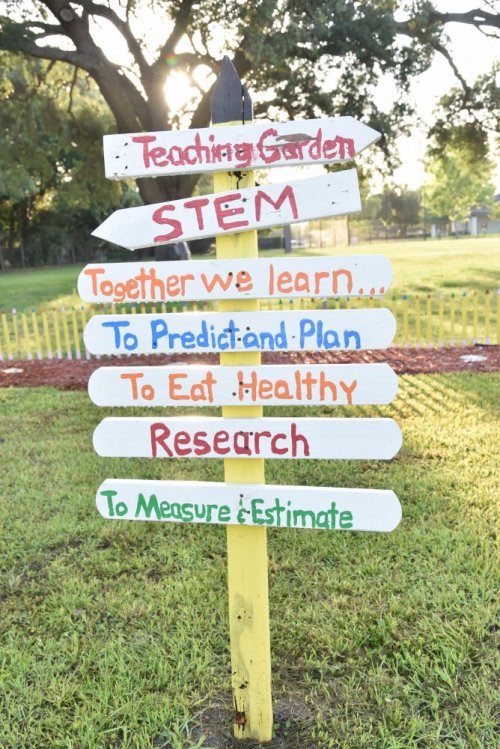
Program participation
Orange Center has 345 students and 98 percent identify as minorities, predominantly African American. Approximately half of the students (150) are part of the school’s STEM magnet program. As a Title I school, 100 percent of Orange Center’s students qualify for free or reduced lunch.
All students take part in the fall planting day and the spring harvest event. The American Heart Association garden curriculum, which targets Pre-K to 5th grade, is used for lessons throughout the year. The school’s STEM coordinator works with all grades and students on garden-related activities. Parents and community members get involved through special events and the farmers market.
Partnership and hospital role
While Arnold Palmer Hospital provides core funding and support for the garden, partners played an integral role in the garden’s creation and continue to contribute to the program’s success.
- American Heart Association: The Orange Center Elementary garden project was established through Orlando Health’s sponsorship of the American Heart Association. With Orlando Health’s financial support, American Heart Association provided the garden foundation, including plants, soil, and materials for beds and contributed a curriculum that teaches nutrition, math, and science. The association’s participation in the garden has since ended.
- Orange Center Elementary: The high level of involvement from school administration and teachers and the strong focus on children's' achievement have been key factors in the garden’s success. The school created a second garden to provide further space for learning and exploration. LIFT Orlando: LIFT Orlando is a community transformation project that directly impacts children and families in an effort to break the cycle of intergenerational poverty. The collaboration with LIFT creates unique circumstances that support both the garden and overall community health. For instance, LIFT is developing mixed-income housing around the school that aims to increase community cohesion.
- Community supporters: Special events serve to expand community engagement. In 2016-17, the Orlando Ballet and Orlando City Soccer Club both participated in events, running activity stations for students.
Financing
Orlando Health provides financial and in-kind support for the garden. Financial support goes toward garden maintenance ($5000 per year) and activities. Hospital team members dedicate time to delivering health and nutrition education and to planning and carrying out planting and harvest days. A major focus of community benefit staff member work is in maintaining strong community engagement to support the hospital’s intention of long-term involvement. School leaders are adept at tapping into community resources and have developed relationships with a range of other community-based organizations to support garden activities. A farmers market, established and run by students, also raises funds for the school.
Program evaluation and impacts
Orlando Health and Orange Center each conduct program evaluation. Orlando Health uses pre and post surveys in each grade to assess knowledge base and retention for educational activities. Questions focus on understanding of different types of foods and the nutrient content and health benefits of foods.
The pre-test helps team members determine the best approach for working with the students and what topic areas to focus on. The post-test is used to assess change in student knowledge and information retention and to identify areas to target in the future. The most recent data (2015-16), drawn from the 48 percent of students who completed both the pre- and post-test, found 82 percent improved their scores. Orlando Health also includes a station for collecting biometric data (height, weight, body mass index) at both the annual planting and harvest events and plans to analyze this data to assess changes over time.
Orange Center is tracking how the garden impacts student achievement and behaviors. Stephanie Carrington, STEM Coordinator, reported the school has seen improvements in academic achievement related to the garden and also observed changes in the cafeteria, namely students choosing more of the healthy offerings. Carrington notes that changes in the foods students can access and choose in the cafeteria are especially important due to the local food environment.
“There is a lack of healthy options and it is hard to make healthy choices when you are surrounded by unhealthy options.”— Stephanie Carrington, Orange Center Elementary STEM coordinator
Assistant principal LaTonya Smothers expressed that the garden has been valuable in growing students’ understanding of ecosystems. She points out that many students lacked an understanding of the role of insects and have learned “every being has a role.”
During the 2017-18 school year, Orange Center is re-designing parts of the garden and students will work on engineering and irrigation design, as part of the process.
Lessons learned
Arnold Palmer Hospital has learned a great deal about the challenges of, and rewards from, working with schools. A key lesson has been the need for flexibility. All parties recognize a need for give and take to make sure activities work for students, administration, and the Orlando Health team members. Team members have worked with the school to make sure activities are consistent and feasible, given the demands on their time (team members may not be available to run a program weekly, so it has to be monthly). Identifying champions at the school to work with has been important to the program. At Orange Center, the STEM and physical education teachers have played this role.
Recently, the hospital funded a second garden at a nearby school, which offered lessons in replicability. Pineloch Elementary has a student population nearly three times larger than Orange Center. To accommodate such a large number, team members have adapted their approach. Changes include involving individual classrooms in specific activities (one class prepares soil, another class plants seeds, etc.) to ensure all students take part in an aspect of the garden work. Working with a larger school has presented certain communication and engagement challenges as well, simply due to the increase in the number of school staff members and families involved in the program.
Second Harvest Food Bank of Central Florida
Orlando Health supports Second Harvest Food Bank of Central Florida and its partner agencies to increase their ability to provide fresh food and healthy meals.
- Program type: Food bank
- Program administrator: Second Harvest Food Bank of Central Florida
- Program support: 2016 and 2017
- Hospital role: Provide grant support; participate in a community collaboration
- Community partners: Feeding America, United Way
- Population served: Low-income individuals and families
- Program goal: To increase access to nutritious foods for highly vulnerable populations
- Health needs addressed: Healthy food access, obesity, and diet-related disease
- Key outcomes: Hospital funding allowed for purchase of refrigeration units to enable storage and distribution of fresh foods, and will support new healthy food box program.

Project description
Through its grant program, Orlando Health helped to expand distribution capacity of Second Harvest’s network agencies and is supporting a new project to connect food-insecure patients and their families to food resources. Orlando Health team members serve on Second Harvest’s Health and Hunger Task Force, which consists of 15 organizations from across central Florida. This task force aims to build relationships and collaboration between the Second Harvest network, health care, and underserved communities. Orlando Health team members also sit on the Second Harvest board of directors.
Partnerships and hospital role
Orlando Health provides financial and staff resources to support the Second Harvest Food Bank of Central Florida. With grant support for Second Harvest, Orlando Health intends to bolster the region’s emergency food network and to ensure clients have access to nutritious food choices that support their health needs. Orlando Health also participates in the new Health and Hunger Task Force, which aims to strengthen the relationships between Second Harvest, health care institutions, and the at-risk populations who rely on the emergency food system.
Financing
- 2016: Orlando Health awarded a grant of $12,700 to Second Harvest to fund the purchase of three refrigeration units by partner organizations. The refrigeration enabled food pantries to store and distribute “highly nutritious, perishable produce, dairy, and protein” and supported nutrition education for clients.
- 2017: Second Harvest received a $20,000 grant to support a healthy food box program, which provides healthy meals to high-risk, low-income individuals. Orlando Health’s care coordination team identifies eligible patients to receive vouchers for the meal boxes, which contain components for 16 healthy meals (four meals for a family of four or 16 meals for an individual). Second Harvest and Orlando Health work together to administer the program and to distribute meal boxes.
Program evaluation and impacts
Second Harvest evaluates its programs and impacts independently of Orlando Health. For the meal program, Orlando Health will track whether referred patients use the vouchers to get meals and will follow their health status over the long term, looking at biometrics and how often and why patients access care.
Goldsboro Farmers Market, Seminole County
This weekly farmers market aims to increase healthy food access and to create business opportunities for residents.
- Program type: Farmers market
- Program administrator: Florida Department of Health in Seminole County
- Program founded: 2016
- Hospital role: Provide grant support
- Community partners: Goldsboro Front Porch Council, City of Sanford, Westside Community Center
- Population served: Residents of Goldsboro neighborhood
- Program goal: To increase access to healthy foods
- Health needs addressed: Healthy food access
- Key outcomes: Market size has increased from three to six vendors since its launch in December 2016.

Project description
In 2016, Orlando Health provided seed funding to the Florida Department of Health in Seminole County to create a weekly farmers market at the Westside Community Center in the Goldsboro neighborhood of Sanford. Goldsboro is a historic African-American, and formerly agricultural community, that now has insufficient access to fresh, healthy food.In the short term, the market aims to increase access to nutritious food, making healthy options convenient and affordable for a population that lacks access to a grocery store and faces significant health issues. The long-term objectives are to influence healthy eating choices, to reduce diet-related disease rates, and to engage residents who grow food to participate as vendors.
Program Participation
The target population for the farmers market is the Goldsboro neighborhood, however, the market is open to all.
Partnerships and hospital role
The Goldsboro Market was organized by the Florida Department of Health in Seminole County, Goldsboro Front Porch Council, and the City of Sanford. The hospital provided grant support.
Financing
Orlando Health provided a $25,000 grant to fund a coordinator position, marketing, and setup costs (both materials and to support vendor participation). Orlando Health awarded a $15,000 grant in 2017 to support market expansion.
Program evaluation and impacts
Since its launch in December 2016, the number of vendors participating in the market doubled from three to six. Approximately 40 residents attend the market each week.
Lessons learned
Sound knowledge and understanding of compliance issues, from business licensure requirements for vendors to municipal regulations around tents, is imperative for an efficient startup process. As a government entity, the department of health had to follow specific purchasing procedures, and farmers had to become approved state vendors. This circumstance created challenges, such as longer payment periods for businesses. Going forward, Goldsboro Front Porch Council will be the fiscal sponsor, eliminating the need for vendors to be state approved. The Department of Health will maintain active involvement in market operations and promotion.
Market visibility is another core element that influences success. The market location hindered its visibility. Project partners are now discussing alternate locations that would increase market visibility, with a specific eye towards a permanent site.
In creating the farmers market, the Department of Health intended to increase access to fruits and vegetables. Department of Health staff members realized, in the course of the project, that “farmers market” conjures a particular image, namely one that includes fruits and vegetables, as well as a variety of novelty and artisan made items. The marketing efforts focused on access issues, rather than connecting to the broad local food movement. In an effort to increase attendance and market use, vendors selling artisan items were added. Going forward, they are determining how best to promote the market to increase attendance (making it worthwhile for vendors) and to increase access (for instance by ensuring Supplemental Nutrition Assistance [SNAP] benefits are accepted).
Ongoing work
Orlando Health is continually exploring how to best support healthy food access for vulnerable populations in the communities it serves. Orlando Health is strongly committed to continued support of the Orange Center healthy teaching garden. Through its participation in LIFT, the hospital hopes to increase community involvement in the garden, supporting the growth of connections and relationships among the neighborhoods diverse residents.
Orlando Health recognizes the need for tailored approaches to address unique health needs within high-risk populations and is also supporting new programs that do so:
- Libby’s Pink Ribbon Garden: This garden serves breast cancer patients and survivors. The garden operates on a give-one-get-one model with breast cancer survivors growing organic vegetables that they can harvest for themselves and for distribution to low-income and under- or uninsured breast cancer patients. In fall of 2017, they will launch a pilot to study the impact of a plant-based diet for breast cancer patients.
- Seniors First: Orlando Health awarded a $15,000 grant to fund Senior’s First, a meals on wheels program for high-risk seniors. The grant will support 30 days of meals (an estimated 2,000 total meals) to seniors who have recently been discharged from a hospital or have recently lost a caregiver.
Orlando Health is also supporting a new farmers market, in collaboration with the City of Orlando and Orlando City Soccer Club, located adjacent to the LIFT Orlando footprint. As a system, Orlando Health intends to further address food security and healthy food access issues through the implementation of food insecurity screenings and food donations and distribution.
